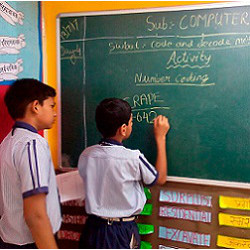
Bhumika and Pushkar, 12-year-old students from a government school in the village of Takalkarwadi, in Khed, Maharashtra, are playing the “Guess My Birthdate” game. The goal of the game is to find the date by asking the least number of questions. The students’ strategy is to analyze each question in terms of the number of dates it eliminates.
Some 300,000 students from 750 schools in 11 states throughout India are learning computing through “unplugged” activities as part of CSpathshala,1 ACM India’s education initiative. The name CSpathshala is derived from computer science and Pathshala, which means place of learning or a school. Launched in 2016, CSpathshala’s primary goals are to promote computer science education in K–12, to influence policymakers to introduce computing into mainstream curricula, and to train teachers so that every child in India learns computing as a science by 2030.

Figure. “Guess my Birthdate” activity at Takalkarwadi School, Maharashtra.
The National Policy on ICT for School Education in India6 advocates the development of a model Curriculum for ICT that would include conceptual knowledge enhancement and enable the development of generic skills with focus on digital literacy. Although teaching computer science has already been introduced in urban India, it focuses primarily on digital literacy and a bit of programming.
Some 300,000 students from 750 schools in 11 states throughout India are learning computing through “unplugged” activities as part of CSpathshala, ACM India’s education initiative.
Introducing a computing curriculum has not been easy and has posed several unique challenges:
- Scale: As per government reports,7 India has over 1.6 million schools offering K–12 education to 300 million students. To compound the problem, in addition to two national boards of education, each of the 29 states in India has its own education board! While English is the common language of instruction in the urban areas, 70% of the population residing in the rural areas is educated in the state’s regional language.
- Infrastructure: 63% of the schools have electricity and only 27% of schools have computers. In rural areas, electricity may be available for a few hours a day and the school may have only 1–2 computers. Urban schools are better equipped with computer labs that allow a computer to be shared by 2–3 students.
- Teacher skills: A survey we conducted corroborated findings in Raman et al.12 Teachers from rural areas had no computing background. Moreover, only 59% of the teachers working in urban areas had exposure to some form of computing education, with only 10% having a computer science degree.
A national curriculum committee explored the CSTA K–12 curriculum framework and recommendations,9 CAS U.K. curriculum,2 code.org lessons,a Computer Masti,8 and CS unplugged material,4 and have developed an unplugged computing curriculum5 influenced by the New Jersey discrete math curriculum for problem solving.10 It includes topics like systematic listing, counting and reasoning (systematically arriving at all possible answers and reasoning on completeness), iterative patterns and processes (looking for patterns to generalize and apply to given problem), organizing and processing information (data collection, representation, and analysis), discrete mathematical modeling (abstractions like graphs and trees), following and devising instructions (initially following, then devising a precise set of instructions and later evaluating multiple solutions) and programming.
Strategies to address the challenges mentioned here include:
- Efforts have been directed toward carrying out a pilot program with 500+ rural government schools and working with 2–3 education boards. The Tamil Nadu state education board has adopted computational thinking as part of its math curriculum for 10,000 schools. Another state educational board will begin a pilot shortly with 1,500 schools. Teaching aids have been translated into three regional languages enabling reach beyond English medium schools.
- Developed an unplugged curriculum to overcome lack of infrastructure.
- Prioritized teacher training and creation of teaching aids. Some 250+ CSpathshala volunteers have created teaching aids for 200+ lessons for grades 1–8 that are distributed under CC license; 3,700 teachers from 1,850 schools have been trained through 70 training programs, all at no cost to schools.
From 5,000 students in 15 pilot schools in 2016–2017, the initiative has been steadily making inroads. Cambridge University Press has partnered with CSpathshala to publish CS educational books, thereby increasing the reach. While the feedback from teachers has been very encouraging, the annual conference on computational thinking for schools11 revealed that an increasing number of teachers are integrating computational thinking with math curriculum as well as developing innovative pedagogical methods to engage students. Teachers are applying a systematic problem-solving approach and extending it to other subjects. Formal studies will be undertaken to measure the impact of the program.
CSpathshala’s primary goals are to promote computer science education in K–12, to influence policymakers to introduce computing into mainstream curricula, and to train teachers so that every child in India learns computing as a science by 2030.
With CSpathshala, a formal computing education is now available to students in rural India who have traditionally been deprived of the same.

Figure. The CSpathshala education initiative teaches computer science using “unplugged” activities.



Join the Discussion (0)
Become a Member or Sign In to Post a Comment